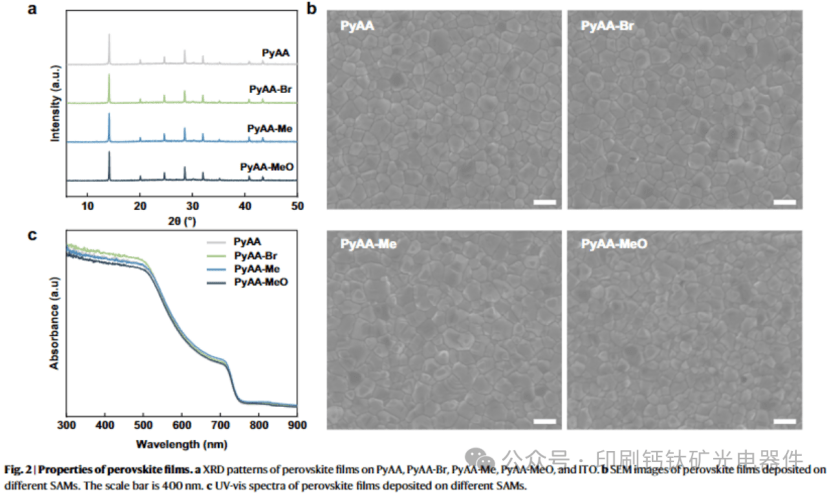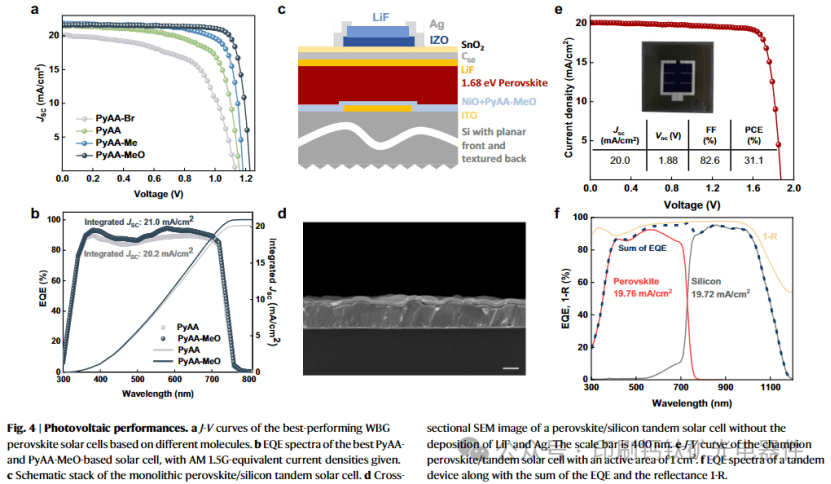Self-assembled monolayers (SAMs), acting as hole-selective contacts, play a pivotal role in ensuring high-performance perovskite photovoltaic devices. Optimal energy level alignment between SAMs and perovskites is crucial for ideal photovoltaic performance. However, many SAMs have been predominantly studied in the context of optimal bandgap perovskites, with limited energy level modifications specifically tailored for wide-bandgap perovskites. In response to this challenge, a research team led by Academician Yang Deren and Researcher Xue Jingjing from Zhejiang University published a paper in Nature Communications titled “Inductive effects in molecular contacts enable wide-bandgap perovskite cells for efficient perovskite/TOPCon tandems.” The study demonstrates that the energy levels of SAMs can be systematically and progressively tuned through the inductive effects of their conjugated moieties, enabling rational design for specific perovskite bandgaps. Wide-bandgap perovskite devices based on these tuned SAMs achieved a power conversion efficiency (PCE) of 22.8%. Upon integration with crystalline silicon TOPCon sub-cells, a perovskite/TOPCon tandem device with a PCE of 31.1% (certified at 30.9%) was further constructed.

SAMs Energy Level Tuning Strategy Based on Inductive Effects
By introducing electron-withdrawing/electron-donating groups (such as bromine, methyl, and methoxy) into the conjugated pyrene core, the electronic density and energy levels of SAMs were systematically regulated through inductive effects. This approach achieved, for the first time, precise energy level alignment between SAMs and wide-bandgap perovskites, overcoming the limitations of traditional SAMs in adapting to narrow-bandgap perovskites.
High-Performance Wide-Bandgap Perovskite Devices and Tandem Integration
The optimized methoxy-modified SAM (PyAA-MeO) enabled a wide-bandgap perovskite single-junction device to achieve an efficiency of 22.8% (VOC 1.24 V, FF 84.3%). The unencapsulated device maintained over 99% of its efficiency after 400 hours of operation at 60°C. Upon integration with TOPCon silicon sub-cells, the tandem device achieved an efficiency of 31.1% (certified at 30.9%) and a fill factor (FF) of 82.6%, ranking among the highest efficiencies for similar tandem systems.
Stability Breakthrough with Fully Conjugated Rigid Molecular Structures
SAMs were constructed using a peripherally fused polyaromatic pyrene core, with a fully conjugated backbone imparting strong structural rigidity and chemical inertness. After 2500 hours of accelerated aging tests, the device maintained over 96% of its efficiency, significantly outperforming traditional N-substituted π-conjugated SAMs and providing a stability foundation for commercialization.




Future Prospects
Further exploration of the inductive effects of diverse functional groups (such as nitro and amino groups) will expand the tuning range of SAMs’ energy levels, enabling adaptation to even wider-bandgap perovskites (e.g., >1.8 eV). Combining theoretical calculations with experimental characterizations will provide universal guidance for efficient molecular design by deeply analyzing the structure-activity relationships between inductive effects and interface charge transport.
Development of SAMs deposition techniques suitable for roll-to-roll printing or blade coating processes will bridge the process gap between small-area laboratory preparations and large-scale production. Optimization of the interface engineering in perovskite/TOPCon tandem devices (such as thickness regulation of tunnel oxide layers and compatibility of recombination layers) will enhance device uniformity and reliability, promoting the commercialization of low-cost, high-stability tandem modules.


